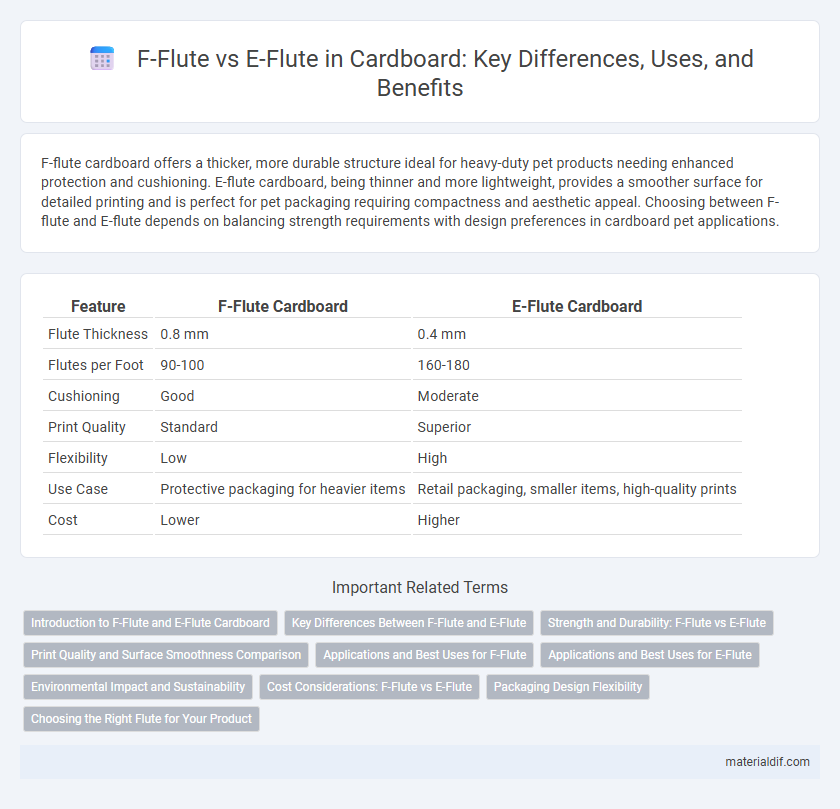F-flute cardboard offers a thicker, more durable structure ideal for heavy-duty pet products needing enhanced protection and cushioning. E-flute cardboard, being thinner and more lightweight, provides a smoother surface for detailed printing and is perfect for pet packaging requiring compactness and aesthetic appeal. Choosing between F-flute and E-flute depends on balancing strength requirements with design preferences in cardboard pet applications.
Table of Comparison
| Feature | F-Flute Cardboard | E-Flute Cardboard |
|---|---|---|
| Flute Thickness | 0.8 mm | 0.4 mm |
| Flutes per Foot | 90-100 | 160-180 |
| Cushioning | Good | Moderate |
| Print Quality | Standard | Superior |
| Flexibility | Low | High |
| Use Case | Protective packaging for heavier items | Retail packaging, smaller items, high-quality prints |
| Cost | Lower | Higher |
Introduction to F-Flute and E-Flute Cardboard
F-flute cardboard offers a thickness of approximately 3.6mm, providing excellent cushioning and durability for protective packaging in shipping and storage. E-flute cardboard, thinner at around 1.6mm, is ideal for retail packaging where a smooth surface and high-quality printability are essential. Both F-flute and E-flute corrugated boards balance strength and lightweight design but cater to different packaging needs based on thickness and structural properties.
Key Differences Between F-Flute and E-Flute
F-flute cardboard features a flute thickness of approximately 1.6 mm, offering superior cushioning and impact resistance, ideal for fragile or heavy items. E-flute cardboard is thinner, around 0.8 mm, providing excellent printability and a smoother surface, making it suitable for retail packaging and high-quality graphics. The key differences between F-flute and E-flute lie in their flute size, durability, and application, with F-flute favored for strength and E-flute preferred for aesthetic appeal.
Strength and Durability: F-Flute vs E-Flute
F-flute cardboard offers enhanced strength and greater durability with a thicker profile, making it ideal for heavy or fragile packaging requiring superior cushioning and impact resistance. E-flute cardboard provides a thinner, more compact structure, delivering sufficient strength for lighter, smaller products while offering excellent printability and a smoother surface finish. Choosing between F-flute and E-flute depends on the specific packaging requirements, balancing durability needs against the desired aesthetics and material efficiency.
Print Quality and Surface Smoothness Comparison
E-flute cardboard offers superior print quality and smoother surface texture compared to F-flute due to its finer and thinner corrugation, which allows for high-resolution graphics and detailed images. F-flute has a slightly rougher surface and larger flute size, resulting in less precise print reproduction, but it provides better cushioning and durability. For packaging that demands sharp, vibrant prints and a sleek finish, E-flute is the optimal choice over F-flute.
Applications and Best Uses for F-Flute
F-flute cardboard offers superior cushioning and stacking strength compared to E-flute, making it ideal for packaging fragile goods such as electronics and glassware. Its thicker profile provides enhanced protection during shipping and better compression resistance for heavy or bulky items. F-flute is best suited for applications requiring extra durability without sacrificing print quality, such as retail packaging and industrial shipping containers.
Applications and Best Uses for E-Flute
E-flute cardboard offers a thickness of approximately 1.5mm, providing superior crush resistance and a smoother surface ideal for high-quality printing, making it perfect for retail packaging, luxury product boxes, and point-of-purchase displays. Its fine flute structure enhances durability while maintaining flexibility for intricate die-cutting and folding, suited for packaging electronics, cosmetics, and small fragile items. Compared to F-flute, E-flute excels in applications requiring a balance of strength and aesthetic appeal, delivering both protection and premium presentation.
Environmental Impact and Sustainability
F-flute cardboard offers superior cushioning and durability with thicker flutes, resulting in increased material usage and a larger carbon footprint compared to E-flute. E-flute is thinner, reducing raw material consumption and enabling higher recyclability, which enhances sustainability and lowers environmental impact. Choosing E-flute packaging supports eco-friendly initiatives by minimizing waste and promoting resource efficiency in the supply chain.
Cost Considerations: F-Flute vs E-Flute
F-flute cardboard offers a lower cost solution compared to E-flute due to its thicker profile which uses less material and manufacturing complexity. E-flute, with finer corrugation, increases production costs but provides better surface printing and durability for premium packaging. Choosing between F-flute and E-flute depends on balancing budget constraints with the need for packaging strength and print quality.
Packaging Design Flexibility
F-flute cardboard offers superior cushioning and durability, making it ideal for packaging heavy or fragile items, while E-flute provides a thinner profile suited for high-end retail packaging that requires fine graphics and intricate die-cut designs. The smaller flutes of E-flute enable more precise printing and folding, enhancing the visual appeal and allowing for complex packaging designs with sharp creases. F-flute's thicker structure limits detailed graphic presentation but excels in providing robust protection, making the choice dependent on the packaging's balance between strength and design sophistication.
Choosing the Right Flute for Your Product
Choosing the right flute for your cardboard packaging is crucial for balancing strength and printability. F-flute offers a thinner profile with higher crush resistance, ideal for small, lightweight products requiring fine graphic detail. In contrast, E-flute combines moderate thickness with excellent puncture resistance, making it suitable for medium-weight items that need both durability and attractive printing surfaces.
F-flute vs E-flute Infographic

 materialdif.com
materialdif.com